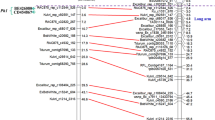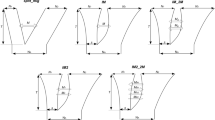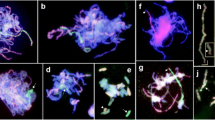Abstract
Paracentric inversion is known to inhibit genetic recombination between normal and inverted chromosomal segments in heterozygous arrangements. Insect inversion polymorphisms have been studied to reveal adaptive processes for maintaining genetic variation. We report the first paracentric inversion in rice (Oryza sativa), which was discovered in our effort to clone the floral organ number gene FON3. Recombination at the FON3 locus on the long arm of chromosome 11 was severely suppressed over a distance of more than 36 cM. An extensive screening among 8,242 F2 progeny failed to detect any recombinants. Cytological analysis revealed a loop-like structure on pachytene chromosomes, whereas FISH analysis showed the migration of a BAC clone from a distal location to a position closer to the centromere. Interestingly, the locations where the genetic recombination suppression began were coincided with the positions of two physical gaps on the chromosome 11, suggesting a correlation between the physical gaps, the inversion breakpoints. Transposons and retrotransposons, and tandemly arranged members of gene families were among the sequences immediately flanking the gaps. Taken together, we propose that the genetic suppression at the FON3 locus was caused by a paracentric inversion. The possible genetic mechanism causing such a spontaneous inversion was proposed.





Similar content being viewed by others
References
Akagi H, Yokozeki Y, Inagaki A, Fujimura T (1996) Microsatellite DNA markers for rice chromosomes. Theor Appl Genet 93:1071–1077
Andolfatto P, Wall JD, Kreitman M (1999) Unusual haplotype structure at the proximal breakpoint of In(2L)t in a natural population of Drosophila melanogaster. Genetics 153:1297–1311
Caceres M, Ranz JM, Barbadilla A, Long M, Ruiz A (1999) Generation of a widespread Drosophila inversion by a transposable element. Science 285:415–418
Chen X, Wu R (1997) Direct amplification of unknown genes and fragments by uneven polymerase chain reaction. Gene 185:195–199
Clark SE, Running MP, Meyerowitz EM (1993) CLAVATA1, a regulator of meristem and flower development in Arabidopsis. Development 119:397–418
Clark SE, Williams RW, Meyerowitz EM (1997) The CLAVATA1 gene encodes a putative receptor kinase that controls shoot and floral meristem size in Arabidopsis. Cell 89:575–585
Dehal P, Predki P, Olsen AS, Kobayashi A, Folta P, Lucas S, Land M, Terry A, Ecale Zhou CL, Rash S, Zhang Q, Gordon L, Kim J, Elkin C, Pollard MJ, Richardson P, Rokhsar D, Uberbacher E, Hawkins T, Branscomb E, Stubbs L (2001) Human chromosome 19 and related regions in mouse: conservative and lineage-specific evolution. Science 293:104–111
Delbert Thomas Morgan JR (1950) A cytogenetic study of inversions in Zea mays. Genetics 35:153–174
Dievart A, Dalal M, Tax FE, Lacey AD, Huttly A, Li J, Clark SE (2003) CLAVATA1 dominant-negative alleles reveal functional overlap between multiple receptor kinases that regulate meristem and organ development. Plant Cell 15:1198–1211
Dobzhansky T (1970) Genetics of the evolutionary process. Columbia University Press, New York
Fletcher JC (2001) The ULTRAPETALA gene controls shoot and floral meristem size in Arabidopsis. Development 128:1323–1333
Gong ZY, Wu HK, Cheng ZK, Gu MH (2002) Physical mapping of the 45S rDNA and 5S rDNA to rice prometaphase chromosome. Yi Chuan Xue Bao 29:241–244
Hoffmann AA, Sgro CM, Weeks AR (2004) Chromosomal inversion polymorphisms and adaptation. Trends Ecol Evol 19:482–488
Huang H, Ma H (1997) FON1, an Arabidopsis gene that terminates floral meristem activity and controls flower organ number. Plant Cell 9:115–134
Huang H, Ma H (1998) The nature of the Arabidopsis fon1 mutations. Plant Cell 10:3–4
Jacobsen SE, Meyerowitz EM (1997) Hypermethylated SUPERMAN epigenetic alleles in Arabidopsis. Science 277:1100–1103
Jacobsen SE, Sakai H, Finnegan EJ, Cao X, Meyerowitz EM (2000) Ectopic hypermethylation of flower-specific genes in Arabidopsis. Curr Biol 10:179–186
Jiang J, Gill BS, Wang GL, Ronald PC, Ward DC (1995) Metaphase and interphase fluorescence in situ hybridization mapping of the rice genome with bacterial artificial chromosomes. Proc Natl Acad Sci USA 92:4487–4491
Jiang L, Qian Q, Mao L, Zhou QY, Zhai WX (2005) Characterization of the rice floral organ number mutant fon3. J Integr Plant Biol 47:100–106
Kato KK, Palmer RG (2003) Genetic identification of a female partial-sterile mutant in soybean. Genome 46:128–134
Kayes JM, Clark SE (1998) CLAVATA2, a regulator of meristem and organ development in Arabidopsis. Development 125:3843–3851
Kushalappa K, Suresh-Kumar MB, Patwardhan L, Vijayraghavan U (1996) Isolation and characterization of genes that control inflorescence. Rice genetics, III. IRRI, Manila, pp 888–893
Laufs P, Autran D, Traas J (1999) A chromosomal paracentric inversion associated with T-DNA integration in Arabidopsis. Plant J 18:131–139
Librojo AL, Khush GS (1986) Chromosomal location of some mutant genes through the use of primary trisomics in rice. In: Rice genetics. IRRI, Manila, pp 249–255
Lister C, Jackson D, Martin C (1993) Transposon-induced inversion in Antirrhinum modifies nivea gene expression to give a novel flower color pattern under the control of cycloidearadialis. Plant Cell 5:1541–1553
Mathiopoulos KD, della Torre A, Predazzi V, Petrarca V, Coluzzi M (1998) Cloning of inversion breakpoints in the Anopheles gambiae complex traces a transposable element at the inversion junction. Proc Natl Acad Sci USA 95:12444–12449
McCouch SR, Kochert G, Yuu ZH, Wang ZY, Khush GS, Coffman WR, Tanksley SD (1988) Molecular mapping of rice chromosomes. Thero Appl Genet 76:815–820
McCouch SR, Teytelman L, Xu Y, Lobos KB, Clare K, Walton M, Fu B, Maghirang R, Li Z, Xing Y, Zhang Q, Kono I, Yano M, Fjellstrom R, DeClerck G, Schneider D, Cartinhour S, Ware D, Stein L (2002a) Development and mapping of 2240 new SSR markers for rice (Oryza sativa L.). DNA Res 9:199–207
McCouch SR, Teytelman L, Xu Y, Lobos KB, Clare K, Walton M, Fu B, Maghirang R, Li Z, Xing Y, Zhang Q, Kono I, Yano M, Fjellstrom R, DeClerck G, Schneider D, Cartinhour S, Ware D, Stein L (2002b) Development and mapping of 2240 new SSR markers for rice (Oryza sativa L.) (supplement). DNA Res 9:257–279
Moon S, Jung KH, Lee DE, Lee DY, Lee J, An K, Kang HG, An G (2006) The rice FON1 gene controls vegetative and reproductive development by regulating shoot apical meristem size. Mol Cells 21:147–152
Nagasawa N, Miyoshi M, Kitano H, Satoh H, Nagato Y (1996) Mutations associated with floral organ number in rice. Planta 198:627–633
RGP (2002) http://rgp.dna.affrc.go.jp/E/publicdata/caps/chr11.html
Robbins TP, Carpenter R, Coen ES (1989) A chromosome rearrangement suggests that donor and recipient sites are associated during Tam3 transposition in Antirrhinum majus. Embo J 8:5–13
Running MP, Fletcher JC, Meyerowitz EM (1998) The WIGGUM gene is required for proper regulation of floral meristem size in Arabidopsis. Development 125:2545–2553
Sambrook J, Fritsch EF, Maniatis T (1989) Molecular cloning: a laboratory manual, 2nd edn. Cold Spring Harbour Laboratory, New York
Scanlon MJ, Chen KD, McKnight CI (2000) The narrow sheath duplicate genes: sectors of dual aneuploidy reveal ancestrally conserved gene functions during maize leaf development. Genetics 155:1379–1389
Seah S, Yaghoobi J, Rossi M, Gleason CA, Williamson VM (2004) The nematode-resistance gene, Mi-1, is associated with an inverted chromosomal segment in susceptible compared to resistant tomato. Theor Appl Genet 108:1635–1642
Sturtevant AH (1919) Contributions to the genetics of Drosophila melanogaster. III. Inherited linkage variations in the second chromosome. Carnegie Inst Wash Publ 278:305–341
Suzaki T, Sato M, Ashikari M, Miyoshi M, Nagato Y, Hirano HY (2004) The gene FLORAL ORGAN NUMBER1 regulates floral meristem size in rice and encodes a leucine-rich repeat receptor kinase orthologous to Arabidopsis CLAVATA1. Development 131:5649–5657
Tang D, Guo LB, Zeng DL, Zhang GH, Cheng ZK, Qian Q (2006) Genetic analysis of two extremely segregation distorted population in rice (Oryza sativa L.) (in Chinese). Yi Chuan 28:1256–1264
The Rice Chromosomes 11, 12 Sequencing Consortia (2005) The sequence of rice chromosomes 11 and 12, rich in disease resistance genes and recent gene duplications. BMC Biol 3:20
Tooke F, Battery N (2003) Models of shoot spical meristem function. New Phytol 159:37–42
van der Knaap E, Sanyal A, Jackson SA, Tanksley SD (2004) High-resolution fine mapping and fluorescence in situ hybridization analysis of sun, a locus controlling tomato fruit shape, reveals a region of the tomato genome prone to DNA rearrangements. Genetics 168:2127–2140
Wang W, Zhai W, Luo M, Jiang G, Chen X, Li X, Wing RA, Zhu L (2001a) Chromosome landing at the bacterial blight resistance gene Xa4 locus using a deep coverage rice BAC library. Mol Genet Genomics 265:118–125
Wang WM, Jiang GH, Wang SQ, Zhu LH, Zhai WX (2001b) Construction of a deep coverage rice BAC library and identification of clones associated with disease-resistant genes. Yi Chuan Xue Bao 28:120–128
Wang C, Zhu C, Zhai H, Wang J (2005) Mapping segregation distortion loci and quantitative trait loci for spikelet sterility in rice (Oryza sativa L.). Genet Res 85:97–106
Yu J, Hu S, Wang J, Wong GK, Li S, Liu B, Deng Y, Dai L, Zhou Y, Zhang X, Cao M, Liu J, Sun J, Tang J, Chen Y, Huang X, Lin W, Ye C, Tong W, Cong L, Geng J, Han Y, Li L, Li W, Hu G, Li J, Liu Z, Qi Q, Li T, Wang X, Lu H, Wu T, Zhu M, Ni P, Han H, Dong W, Ren X, Feng X, Cui P, Li X, Wang H, Xu X, Zhai W, Xu Z, Zhang J, He S, Xu J, Zhang K, Zheng X, Dong J, Zeng W, Tao L, Ye J, Tan J, Chen X, He J, Liu D, Tian W, Tian C, Xia H, Bao Q, Li G, Gao H, Cao T, Zhao W, Li P, Chen W, Zhang Y, Hu J, Liu S, Yang J, Zhang G, Xiong Y, Li Z, Mao L, Zhou C, Zhu Z, Chen R, Hao B, Zheng W, Chen S, Guo W, Tao M, Zhu L, Yuan L, Yang H (2002) A draft sequence of the rice genome (Oryza sativa L. ssp. indica). Science 296:79–92
Zhang D, Yang Q, Bao W, Zhang Y, Han B, Xue Y, Cheng Z (2005a) Molecular cytogenetic characterization of the Antirrhinum majus genome. Genetics 169:325–335
Zhang W, Yi C, Bao W, Liu B, Cui J, Yu H, Cao X, Gu M, Liu M, Cheng Z (2005b) The transcribed 165-bp CentO satellite is the major functional centromeric element in the wild rice species Oryza punctata. Plant Physiol 139:306–315
Zhong XB, Bodeau J, Fransz PF, Williamson VM, Kammen Av, Jong JHd, Zabel P (1999) FISH to meiotic pachytene chromosomes of tomato locates the root knot nematode resistance gene Mi-1 and the acid phosphatase gene Aps-1 near the junction of euchromatin and pericentromeric heterochromatin of chromosome arms 6S and 6L, respectively. Theor Appl Genet 98:365–370
Ziegelhoffer EC, Medrano LJ, Meyerowitz EM (2000) Cloning of the Arabidopsis WIGGUM gene identifies a role for farnesylation in meristem development. Proc Natl Acad Sci USA 97:7633–7638
Zohary D (1955) Chiasmata in a pericentic inversion in Zea mays. Genetics 40:874–877
Acknowledgments
We thank the anonymous reviewers for detailed instructions for revising the manuscript and Charles H. Leseberg for his comments. The work was supported by grants from the Ministry of Science and Technology of China (2004CB117201) and the National Natural Science Foundation of China (30228022).
Author information
Authors and Affiliations
Corresponding authors
Additional information
Communicated by R. Hagemann.
Rights and permissions
About this article
Cite this article
Jiang, L., Zhang, W., Xia, Z. et al. A paracentric inversion suppresses genetic recombination at the FON3 locus with breakpoints corresponding to sequence gaps on rice chromosome 11L. Mol Genet Genomics 277, 263–272 (2007). https://doi.org/10.1007/s00438-006-0196-7
Received:
Revised:
Accepted:
Published:
Issue Date:
DOI: https://doi.org/10.1007/s00438-006-0196-7




